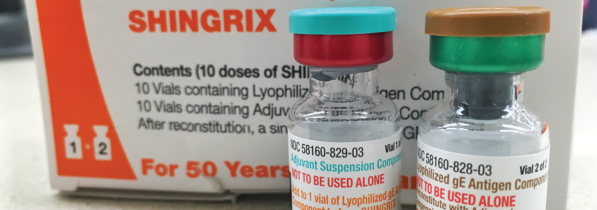
Shingrix
The short version: As many of you know, a new shingles vaccine (“SHINGRIX”) was introduced in the past year, and is recommended for all adults over 50 years of age. The new vaccine is much more effective than the old vaccine (“Zostavax”). The new vaccine is associated with a higher incidence of side effects (such as pain and swelling at the injection site, or flu-like symptoms—achiness, fatigue—typically lasting a day or two after the vaccine), but because of its improved effectiveness, SHINGRIX has essentially replaced the old shingles vaccine. More detailed information from The Medical Letter follows:
The long version:
The FDA has approved an adjuvanted, recombinant varicella zoster virus (VZV) vaccine (Shingrix – GSK) for prevention of herpes zoster (shingles) in adults ≥50 years old. Shingrix is the second herpes zoster vaccine to be approved in the US; Zostavax, a live-attenuated VZV vaccine approved for the same indication, has been available since 2006.1,2
HERPES ZOSTER – Following primary infection, VZV persists in a latent form in sensory ganglia; VZV-specific cell-mediated immunity (CMI) prevents reactivation and multiplication of latent virus. When CMI falls below a critical threshold, as it can in older and immunocompromised persons, VZV can reactivate, causing shingles and, occasionally, postherpetic neuralgia (PHN) and other complications. About 1 million cases of shingles occur in the US each year.3,4
ZOSTAVAX – In clinical trials, the live-attenuated vaccine significantly reduced the incidence and severity of herpes zoster and PHN in adults ≥50 years old, but its effectiveness declines sharply with age (see Table 1), and its protection against shingles wanes to 4% within 8 years after inoculation in persons vaccinated at ≥60 years old.5-9 Zostavax is contraindicated for use in immunocompromised patients and it must be frozen during storage and transport. The Advisory Committee on Immunization Practices (ACIP) recommends Zostavax only for adults ≥60 years old, even though it was approved by the FDA for use in those ≥50 years old.10
SHINGRIX – The new recombinant vaccine contains a surface VZV glycoprotein E (gE) antigen obtained from cultured, genetically engineered Chinese hamster ovary cells that triggers a targeted immune response to VZV. It also contains a liposomal adjuvant (AS01B) to enhance the immune response. Unlike Zostavax, Shingrix is not contraindicated for use in immunocompromised patients and does not need to be frozen during storage and transport.
CLINICAL STUDIES – FDA approval of Shingrix was based on the results of two observer-blind trials, one in adults ≥50 years old and the other in adults ≥70 years old, in which a total of 27,922 persons were randomized to receive two doses of vaccine or placebo two months apart.11,12 The vaccine was effective in preventing herpes zoster and PHN in all age groups. Pooled results of the trials are summarized in Table 1.
The duration of protective immunity against shingles with Shingrix is unknown. In persons ≥70 years old, vaccine efficacy was 85.1% in the fourth year after vaccination.12 Immunogenicity data suggest that the protective effect of Shingrix will persist for at least 9 years after vaccination.13 The efficacy of Shingrix in persons who receive only one dose is not known. Shingrix and Zostavax have not been compared in head-to-head trials.
ADVERSE EFFECTS — Although not directly compared to one another in clinical trials, adverse reactions appear to occur more often with Shingrix than with Zostavax. Common adverse effects of the new vaccine include myalgia (45%), fatigue (45%), headache (38%), shivering (27%), fever (21%), GI symptoms (17%), and injection-site pain (78%), redness (38%), and swelling (26%). Severe local reactions preventing normal daily activities occurred in 17% of persons who received Shingrix and persisted for a mean of 2 days. Serious adverse events, including new-onset immune-mediated disease and death, occurred at similar rates in the vaccine and placebo groups. Long-term data on the safety of Shingrix are lacking.
DRUG INTERACTIONS – The efficacy of Shingrix may be reduced in patients who are receiving immunosuppressive therapy.
DOSAGE AND ADMINISTRATION – Shingrix should be given as two 0.5-mL doses administered intramuscularly 2-6 months apart. It can be given at the same time as influenza vaccine, but a different injection site should be used.
The vaccine is supplied in two single-dose vials, one containing the lyophilized antigen component and the other containing the adjuvant suspension component. Both vials should be refrigerated during storage; the vaccine should be discarded if frozen. Before administration, the antigen component must be reconstituted with the adjuvant component to form an opalescent, colorless to pale-brown liquid. The reconstituted vaccine should either be administered immediately or refrigerated and given within 6 hours. It should be discarded if it appears discolored or contains visible particulates.
NEW RECOMMENDATIONS – The ACIP now recommends that healthy adults ≥50 years old, including those who have already received Zostavax, be vaccinated with two doses of Shingrix (2-6 months apart).10 The committee voted that Shingrix is preferred over Zostavax for herpes zoster prevention. The optimal time between administration of Zostavax and vaccination with Shingrix has not been established.
Update 1/26/18: Since publication, the ACIP has recommended that Shingrix not be given <2 months after vaccination with Zostavax.14
CONCLUSION – The adjuvanted, recombinant varicella zoster virus (VZV) vaccine (Shingrix) appears to be considerably more effective than the live-attenuated VZV vaccine (Zostavax) for prevention of herpes zoster (shingles), especially in older patients. Two doses of Shingrix administered 2-6 months apart are now recommended for healthy adults ≥50 years old, including those who have previously received Zostavax. Ensuring completion of the two-dose series may be challenging, particularly in patients who experience severe adverse effects with the first dose.



